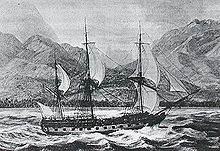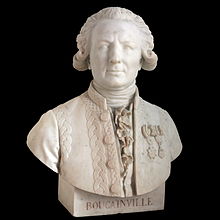Louis Antoine de Bougainville
Louis Antoine de Bougainville (born November 11, 1729 in Paris , † August 31, 1811 there ) was a French officer, navigator and writer . He was the first French to sail around the world.
Life
Bougainville was born in Paris in 1729 on Rue Barre-du-Bec . His parents were the notary Yves Pierre de Bougainville (1686–1754) and Marie Françoise, née Darboulin (approx. * 1700). His brother, Jean-Pierre de Bougainville (1722–1763), and his sister, Marie Françoise Charlotte de Bougainville (1724–1813), and he were orphaned when his mother died in 1734.
In 1752 Bougainville wrote a mathematical work on integral calculus . After he had become secretary of the French embassy in London, he was admitted to the scientific society, the Royal Society in London , in 1756 . In the same year he went to French Canada ( New France ) for several years as an adjutant to General Louis-Joseph de Montcalm , where he fought against Great Britain during the French and Indian War. In the battle of the Plains of Abraham near Québec on September 13, 1759, in which the French suffered a decisive defeat and his superior Montcalm was fatally wounded, Bougainville and the soldiers he led could no longer intervene in time because Montcalm had not waited for his arrival. The absence of bougainville was possibly decisive for battle and war. As a colonel of the infantry he returned to France from English captivity and in 1763 joined the French Navy with the equivalent rank of captain .
With French settlers expelled from Canada and the capital of relatives, he founded a colony on what is now the Falkland Islands in 1764 , which he named after the city of his departure, St. Malo , Les nouvelles Malouines , and which soon numbered around 150 inhabitants. Two years later the islands had to be ceded to Spain , the new masters kept the name in Spanish spelling and referred to the archipelago as Malvinas .
From 1789 he was a member of the Académie des Sciences .
On January 25, 1781 he married Marie Joséphine Flore de Longchamps Montendre († 1806), the couple had four children.
Circumnavigation 1766–1769

In 1766 Bougainville received from the French government under Louis XV. the order to be the first French to sail around the world. At that time, European seafarers were still looking for the Terra Australis Incognita . On Monday, December 15, 1766, Bougainville set sail on the frigate La Boudeuse from Brest . The Fleute L'Étoile left the port of Rochefort on Sunday, February 1, 1767 to support the circumnavigation and met the Boudeuse on Saturday, June 13, 1767 in Rio de Janeiro .
Bougainville was accompanied by naturalists such as the botanist Philibert Commerson and his assistant, disguised as a man, Jeanne Baret , the astronomer Pierre-Antoine Véron (1736–1770) and Karl Heinrich von Nassau-Siegen, known as a bon vivant . In 1768 the ships reached the Pacific . The stay in Tahiti from April 6 to 15, 1768, which Bougainville formally took possession of as Île de la Nouvelle Cythère (New Kythira ) for the French king, should be emphasized . Bougainville was the first Polynesian to bring the son of a tribal prince, Ahutoru (also Aotourou ), to France. He also explored numerous other Pacific islands, such as the New Hebrides , the Louisiads and the Solomon Islands , which he rediscovered after almost 200 years of oblivion, and whose northernmost island was named Bougainville .
Bougainville nearly spotted the east coast of Australia , but turned north east of the Great Barrier Reef . He is said to have said that he literally smelled the country. In September 1768 he reached the Moluccas and finally returned to Saint-Malo in March 1769 via the then Dutch Batavia (now Jakarta ) . Despite the hardship of the journey, he lost only seven men on this trip.
In 1771, Bougainville's detailed travelogue, Voyage autour du monde par la frégate du roi La Boudeuse et la flûte L'Étoile, was published . As a well-known personality in the spirit of the Enlightenment, he helped the theses of Jean-Jacques Rousseau to further popularity with his idealized image of the South Sea islanders as noble savages . The highlight of the report is the stay in Tahiti, the interior of which he describes as the jardin d'Eden (Garden of Eden), which offers its residents everything they need to live. He describes the islanders as friendly, naive and happy people who have not yet been corrupted by civilization.
Friedrich Melchior Grimm , at that time in charge of Correspondance littéraire, philosophique et critique , asked Denis Diderot to write a book review for Bougainville's travelogue. Diderot complied with this wish. The report then inspired Denis Diderot to write his essay Supplément au voyage de Bougainville (1771), ostensibly a defense of sexual freedom. James Cook wrote of this travelogue in 1773: "I consider Bougainville's book to be the most useful and also the most entertaining description of a journey through this sea that has appeared so far."
Services for France, death

In 1772, Bougainville became Louis XV's personal secretary . raised. From 1779 to 1782 he fought as rear admiral and commander of several ships of the line against the British in the battles of the American Revolution . Among other things, he commanded the first squadron of the French fleet in the victorious naval battle off the Chesapeake Bay (September 5, 1781) against the British fleet. For the defeat in the naval battle of Les Saintes (April 12, 1782), however, he was mainly blamed, but a court martial was limited to a public reprimand. After the French Revolution he was offered the newly created Ministry of the Navy in 1791 and a vice-admiral post in 1792, but Bougainville turned it down. He settled on a property in Normandy . He survived the bloody terror , La Terreur (imprisoned in 1794) unscathed despite the well-known kingly attitude only through the fall of Robespierre . In 1794 he became a member of the French Academy of Sciences, and he helped prepare the Egyptian expedition of 1798. In 1799 he became head of the Paris length office . In 1801 he urged Napoleon to reoccupy the Falkland Islands in a memorandum .
Napoleon awarded him several high honors: in 1799 he appointed him Senator, 1804 Grand Officer of the Legion of Honor and 1808 “Count of the Empire” ( Comte d'Empire ). In 1809, in his last official position, he was chairman of the council of war to investigate the defeat of France at the Battle of Trafalgar . There was no longer a planned trip to the North Pole .
Louis Antoine de Bougainville died in Paris at the age of 81. His heart rests in the parish cemetery of the church of St-Pierre de Montmartre ( Cimetière du Calvaire ), the body was transferred to the Panthéon .
Honors
In addition to the largest island in the Solomon Islands archipelago , Bougainville , which politically belongs to Papua New Guinea , a sea area off New Guinea , a deep-sea trench and a coral reef off northeast Australia also bear the name of bougainvilles. His traveling companion on the circumnavigation, the botanist and surgeon Philibert Commerson , named the genus of bougainvillea after his captain.
Furthermore, Cape Bougainville and Port Louis (today only a sheep farm) are named after him on the Falkland Islands .
Awards
- 1804 Grand Officer of the Legion of Honor
- 1808 by Napoléon I. Senator and Count of the Empire appointed
Works (selection)
- Traité du calcul intégral, pour servir de suite à l'Analyse des infiniments petits de M. le marquis de l'Hôpital. (2 volumes, 1754–1756) - Texts en ligne 1 [archive] 2 [archive]
- Voyage autour du monde par la frégate du Roi La Boudeuse et la flute l'Etoile en 1766, 1767, 1768, et 1769. (1 volume, 1771 et 2 volumes, 1772)
- Essai historique sur les navigations anciennes et modern dans les hautes latitudes septentrionales.
- Notice historique sur les sauvages de l'Amérique septentrionale.
German translations
- Louis-Antoine de Bougainville, trip around the world. Via South America and across the Pacific back to France, 1766–1769 . Edited and translated by LM Hoffmann. With 25 contemporary illustrations and maps. Edition Erdmann / Marix-Verlag, Wiesbaden 2010, ISBN 978-3-86539-816-1 [complete. from the Frz. transferred from the editions Neuchâtel 1772 and Lille 1889]
- Louis-Antoine de Bougainville: Journey around the world. Through the islands of the Pacific 1766–1769 . Edited by Detlef Brennecke. Erdmann, Stuttgart et al. 2002, ISBN 3-522-60042-8 , ( old adventurous travel reports ).
- Louis-Antoine de Bougainville: Trip around the world, which was made with the frigate La Boudeuse and the fleutschiff L'Etoile in the years 1766, 1767, 1768 and 1769 . Rütten and Loening, Berlin 1977
literature
- Beatrice Elisabeth Waggaman: Le Voyage autour du monde de Bougainville: droit et imaginaire. Presses universitaires de Nancy, Nancy 1992 ISBN 2-8648-0476-X
- John Dunmore: Louis De Bougainville: Soldier, Explorer, Statesman. University of Alaska Press 2008 ISBN 1-60223-001-3
- "Louis-Antoine de Bougainville." French and Indian War. 2003. HighBeam Research. (June 18, 2014). http://www.highbeam.com/doc/1G2-3411000024.html
Web links
- Literature by and about Louis Antoine de Bougainville in the catalog of the German National Library
- de.forvo.com: Pronunciation of the name Louis Antoine de Bougainville
- deutschlandfunk.de , calendar sheet , March 22, 2017, Irene Meichsner : The circumnavigator Jeanne Baret
- tripota.uni-trier.de: Louis-Antoine de Bougainville
Individual evidence
- ↑ today it is the Rue du Temple
- ↑ Family genealogy
- ^ List of members since 1666: Letter B. Académie des sciences, accessed on September 24, 2019 (French).
- ^ Matthias Glaubrecht: Louis Antoine de Bougainville Or: The unveiling of the world. Part II. Naturwissenschaftliche Rundschau, 64th year, issue 11 2011, online ( Memento of the original from May 31, 2014 in the Internet Archive ) Info: The archive link was inserted automatically and has not yet been checked. Please check the original and archive link according to the instructions and then remove this notice. (PDF; 2.4 MB)
- ^ Jürgen von Stackelberg: Diderot. Artemis-Verlag, Munich 1983, ISBN 3-7608-1303-8 , p. 107
| personal data | |
|---|---|
| SURNAME | Bougainville, Louis Antoine de |
| BRIEF DESCRIPTION | French navigator and writer |
| DATE OF BIRTH | November 11, 1729 |
| PLACE OF BIRTH | Paris |
| DATE OF DEATH | August 31, 1811 |
| Place of death | Paris |




